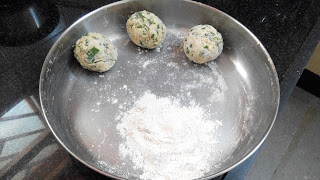Semolina halwa and Bengal
gram (kala chana) dry preparation are made for Devi puja, especially during
Navratri celebrations.
Here’s the recipe for these lip smacking dishes:
Semolina halwa
Ingredients:
-
2 tbsps ghee
-
1 cup Semolina
-
1 cup sugar
-
4 cups water
-
¼ tsp cardamom powder
-
1 tbsp cashew nuts
-
½ tbsp raisins
Instructions:
-
Heat the ghee in a thick bottomed pan and add
the semolina. Lower the flame, keep stirring and add the cashew nuts after
about two minutes.
-
When the semolina turns to brown color, add the
sugar and stir for a few seconds.
-
Add the water, mix well and add the raisins and
cardamom powder. Cover the pan and let it cook for about three minutes.
-
When the consistency is semi solid, remove from
the flame.
Bengal gram dry preparation
Ingredients:
-
1 cup Bengal
gram (kala chana) soaked overnight and pressure cooked with salt and 1½ cups
water for 18 minutes
-
1 tbsp oil
-
½ tsp cumin seeds
-
A pinch of asafetida
-
¾ tsp cut
ginger
-
¼ tsp turmeric powder
-
¼ tsp red chilli powder
-
1 tsp coriander powder
-
½ tsp garam masala powder
Instructions:
-
Drain the cooked Bengal
gram and keep aside.
-
Heat oil in a thick bottomed pan and when it
starts smoking, add the cumin seeds and asafetida.
-
Add the cut ginger and stir, let it turn
brownish.
-
Add the cooked Bengal
gram, and all the masala powders.
-
Stir well and keep on low flame for about two
minutes and remove from fire.





























